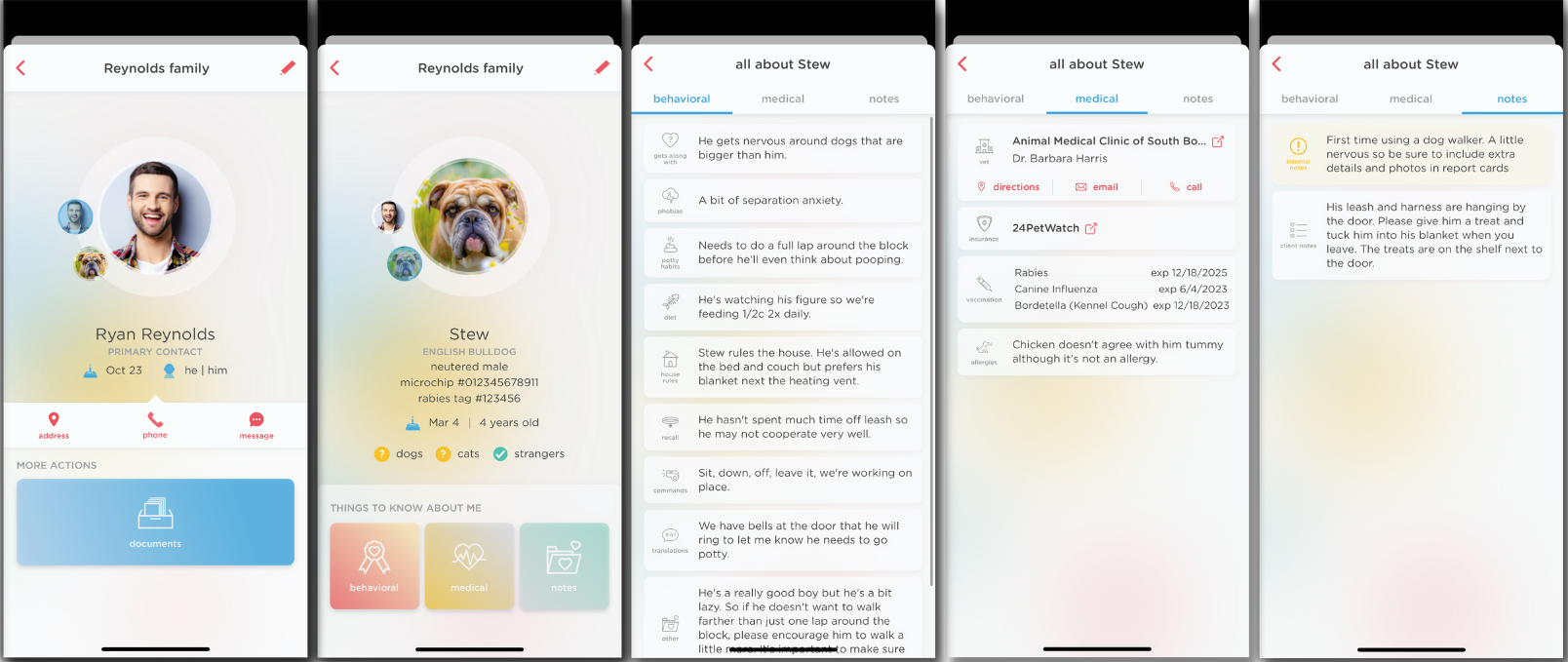
Before taking on a new client, it’s common for dog walkers, pet sitters, dog trainers, and daycare facilities to require a meet & greet to assess and evaluate both the human and the pet. The meet & greet gives you a chance to gather information about the client, understand who their pet gets along with, learn of any medical or behavioral needs or requirements, and overall see if it’s a fit. If you’re not requiring a meet & greet, you may want to consider changing your process to require one. It adds an additional layer of safety, gives everyone a chance to meet one another and get comfortable, and provides an opportunity for you to weed out any clients who may not be the best fit for you and your pack. Let’s dive a little deeper into the benefits of meet & greets and some helpful information to keep them running smoothly and efficiently!
Let’s use the example of a new client, Ryan Reynolds, and his dog, Stew.
Ryan reaches out to you about setting up regular walks for his Bulldog, Stew. He’s been working remotely for the past two years, but now he’s required to go back into the office twice a week. One of his neighbors heard Stew crying on Ryan’s first day back to work and recommended Ryan reach out to you. He’s never used a dog walker before, but he thinks Stew is going to love it!
After taking down Ryan’s basic information, you ask him to get together for a meet & greet. A meet & greet with a potential new client is the perfect opportunity for humans and pets to get to know each other. You’re meeting him after work on Thursday, but before the meeting, you like to have a little more background information.
Do your homework and ask prospective clients to do theirs too
To help keep things running smoothly and to make the most of everyone’s time, you give Ryan some homework to complete before the meetup. One way to collect this information is by asking them fill out an intake form online (using tools like Google Forms, JotForm, or Typeform). It’s a good idea to require an email address on your website’s contact form so that you can send any instructions or intake forms via email. If you’re using an all-in-one software like PetPocketbook to manage your client information, you can invite Ryan to join and fill out a profile directly in your client portal for pet parents.
So, what information should you collect?
As not to overwhelm Ryan, explain what information is required vs. what’s nice to have. Depending on what services you offer, you may require more or less information from your clients. For example, if you’re going to be adding Stew to your pack walks, you’ll need to know a good amount of information about how he gets along with other dogs. But if you’re only taking him on solo walks – a simple yes, he gets along with other dogs, or no, he’s more of a lone wolf, will do.
The basics. Start with contact information (e.g., phone number, email, home address and any access instructions) and some basics about the pets you’ll be caring for, like their name, pet type (i.e. dog, cat, turtle, etc.), breed, gender, and if are desexed or intact.
Pet behavior. Some of the most important and helpful information you can collect about a pet is their behavioral information. If you’re a dog walker, before you take a dog out for a walk the first time, wouldn’t it be helpful to know if they’re leash reactive, if they do well off leash or not, or if they only get along with smaller dogs? Without it, you may unintentionally put yourself, the dog, or others, in danger. Having some background of their behavior or quirks keeps everyone safe and happy. Not to mention that it’s good practice as a professional dog walker to help reinforce any training that the dog might have had to ensure consistency when they are in your care, but to do so, you’ll need to collect that information and have it handy. You’ll get a chance to review this information later with Ryan so that you will feel comfortable handling Stew in different situations.
Medical information. Say you’re hiking with Stew out on the trails, and his paw gets cut up on a rock. Because emergencies like this can happen, it's important to have medical information like his vet’s contacts and a vet release in your files so that you can get him to the vet as soon as possible. For some businesses, vaccinations may be required (sometimes even by law) – especially if the dog will be around other dogs and could pick something up from them. If you’re using software like PetPocketbook to manage your client information, you’ll be able to get reminders about any pets who have vaccines that are about to expire so that you can help pet parents stay up-to-date. If you’re not sure which vaccines are required for pets in your care, you should check your local state guidelines and requirements to understand what’s needed.
Other. Your intake forms might not explicitly ask about every last detail, and that’s okay! It’s a delicate balance to keep your intake process easy so that it’s not an overwhelming and frustrating experience for your clients while also ensuring that you collect the important information you need to provide the best possible care. So it’s always a good idea to have an area on your intake forms where Ryan can choose to volunteer any additional information he would like to share about Stew. As a pet care provider, you’ve probably seen it all! These notes can help you go above and beyond for your clients. In PetPocketbook, we have an internal notes section too. This comes in handy if you learn something during the meet & greet that’s helpful for you or your staff to know but wouldn’t necessarily want to share with Ryan. For example, “First time using a dog walker. A little nervous so be sure to include extra details and photos in report cards.” That way you’ll always have that information on hand to reference if you need it!
It’s important to remember not every client will fill everything out – some stick to basics, while others will add tons of details. Just remember to let them know what information is required when you share your intake form! Before you head off to your meet & greet, take a few minutes to review the information they have provided and make note of any missing information or things you may have questions about!
In our recent interview with Molly Doherty, owner of Unleashed Baltimore, she explained, “Some clients will share so much about their pets in their profiles and during the meet & greets. I like to fill out the profiles myself after the meet & greet so that I can keep everything short and sweet. That way my staff and I don’t need to read War and Peace (a 1,200+ page book) just to understand the dog is nervous and doesn’t like vacuums. When we’re out in the field, time is of the essence so keeping profiles concise is helpful!”
Don’t have an intake form yet? Click here to download our template, or check out Ryan and Stew’s PetPocketbook profile below for some inspiration!

At the meet & greet
Get excited, it’s time to meet Ryan and Stew in person! And since you’ve already done your homework by collecting all the required information, you can spend this time getting to know them better. After evaluating Stew and reviewing any behavioral information, be sure to add or update everything in your notes or directly in Stew’s profile in the software you use. On your end, it’s helpful to share any tools that you might use like clickers, e-collars, etc. and how you’ll approach working with their pet so that clients know what to expect. If you had any questions after reviewing their intake information, don’t forget to ask so that you have everything you need!
Setting expectations with new clients
Review your processes. Walk Ryan through the process of what it will be like working with you, starting with how to request an appointment. Should he call, text, email, or request appointments online? Do you have a cut off time for requests? How will he know if an appointment is confirmed or not? Beyond scheduling, do you prefer clients to reach out to you a different way for billing questions? Or what about emergencies? It’s best to review all of this together so that you and your clients know what to expect! If you’re using an all-in-one software like PetPocketbook that gives clients access to a pet parent portal, it doesn’t hurt to take a couple minutes to explain the basics of using the software like where to make requests, update their profile, pay for services, and how to message you.
Discuss any policies and additional fees with Ryan so he understands expectations and what he may be responsible for. If you have a cancellation policy, surcharges on holidays and weekends, or a late booking fee, go through them together so that there aren’t any surprises later on.
If anything new comes up during or after the meet & greet, add notes to your completed intake forms (or in our case, edit the Reynolds family’s profile directly in your PetPocketbook portal) to keep it up-to-date. Since the heavy lifting of collecting most of the information has been done, it should be smooth sailing!
Sign your client agreements
If after the meet & greet, you or Ryan decide not to move forward, no problem! That’s what meet & greets are for! You can just remove them as a client from your client management software or archive their intake forms.
If you do decide to work with Ryan and Stew, your work here is mostly done! Since you have already collected all the information you needed before and during the meet & greet, all you need to do now is have Ryan sign your agreements before he starts booking with you.
A service agreement ensures that you and Ryan are bound to the terms of engagement and should include the basics like your policies as well as a waiver of liability to help protect yourself and your business. It’s helpful to include a vet release in your contracts to authorize you to get Stew the needed veterinary care in case of emergencies, without potentially wasting precious time before treatment to get in touch with his parents. If you don’t have any agreements yet, a quick online search should yield some options to choose from as a starting point.
You could print out your agreements for Ryan to sign on paper at the end of your meet & greet, but these days, it’s much easier (and friendlier to our environment!) to send a digital copy instead, whether via email or better yet through a separate tool for e-signatures like DocuSign or HelloSign. If you’re using software like PetPocketbook, you may have the option to send your agreements for Ryan to sign electronically directly through your software. In our case, we offer this service at no additional cost; we’ll even automatically upload the signed agreement to his family profile in your PetPocketbook portal and email a PDF copy to him directly.
That’s it... you’re done! Congratulations on your new client 🥳️
Not using PetPocketbook yet? Schedule a demo to get started with a free 60-day trial!
